Agriculture
As an agrarian community, our daily activities go hand in hand with the seasons. We work our land with horses, planting and harvesting throughout the year. These seasonal cycles of agrarian life provide a mooring and a rhythm for the whole life of the community.
We grow our crops at Homestead Heritage using only natural farming techniques in recognition that many of these methods have proven themselves in agricultural communities for centuries. The thick, lush Sudan grass we plant not only supplies forage for our larger livestock, but also doubles as a natural weed suppressant. In late fall, we plant the lower fields in cover crops of rye or oats and winter peas as part of our crop rotation cycle to rebuild the nitrogen level in the soil. When our draft teams plow them under in the spring, these plants decompose to replenish nutrients for the fields as rich green manure.
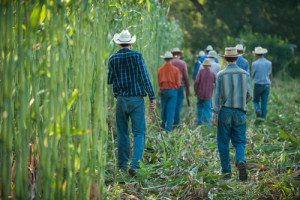 The summer brings a steady rhythm of weeding, watering and harvesting as the various crops mature in season. Everyone pitches in to help. The hot July sun hastens the ripening of the pinto beans, sweet sorghum stalks, sweet corn and our yellow Hickory King corn. When the sweet corn reaches the peak of ripeness, many of us work together to harvest the ears and prepare them for storage. As the days begin to shorten and the temperatures dip, showing signs of the approaching fall, we harvest our sweet potato crop.
The summer brings a steady rhythm of weeding, watering and harvesting as the various crops mature in season. Everyone pitches in to help. The hot July sun hastens the ripening of the pinto beans, sweet sorghum stalks, sweet corn and our yellow Hickory King corn. When the sweet corn reaches the peak of ripeness, many of us work together to harvest the ears and prepare them for storage. As the days begin to shorten and the temperatures dip, showing signs of the approaching fall, we harvest our sweet potato crop.
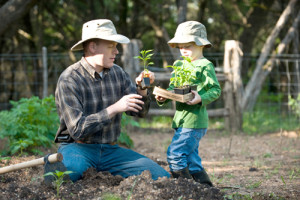 Family gardens flourish on the rich river-bottom land, with a wealth of tender, sweet vegetables: green beans, black-eyed peas, broccoli, carrots, okra, potatoes, pinto beans, onions, tomatoes, bell and jalapeno peppers, sweet corn and squash to name but a few. Families enjoy produce fresh from their gardens and preserve the rest by canning, freezing and drying. Raising, weeding, harvesting and preserving crops, young and old work together as not only the crops are propagated but also the skills, care, diligence and relationships that sustain and enrich life.
Family gardens flourish on the rich river-bottom land, with a wealth of tender, sweet vegetables: green beans, black-eyed peas, broccoli, carrots, okra, potatoes, pinto beans, onions, tomatoes, bell and jalapeno peppers, sweet corn and squash to name but a few. Families enjoy produce fresh from their gardens and preserve the rest by canning, freezing and drying. Raising, weeding, harvesting and preserving crops, young and old work together as not only the crops are propagated but also the skills, care, diligence and relationships that sustain and enrich life.
The native grasses on our upper land serve as pasture for our larger livestock: Percheron and Belgian workhorses, Morgan horses, mules and dairy cattle. Our draft animals are instrumental in the way we cut and store our coastal Bermuda hay—the annual supply of winter food for themselves and the rest of our livestock. After using horse-drawn implements to cut and rake the hay, we haul it on horse-drawn wagons to one side of the hayfield, where we stack it in fifteen- to twenty-foot-tall haystacks. You can see these haystacks from our scenic overlook.
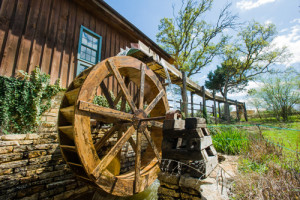 We harvest field crops from late spring through fall, beginning with our oats in mid-May. In June, when the heads of the wheat begin to bend under the weight of the full grains, the mules pull a grain binder through the field, cutting and binding the grain into sheaves. By hand, we stack five sheaves together and place two more across the top to shed any rain while drying. When threshing day arrives, we gather the dried shocks into horse-drawn wagons and haul them to our threshing machine, made in the early 1900’s. In what seems like no time at all, the wheat kernels, now separated from the chaff, fill the grain bins, and we pile the straw in preparation for its later use as winter mulch. With our water-wheel-driven gristmill, we stone-grind the wheat into flour for our community’s use. Surplus wheat, we give away or make available for purchase as stone-ground flour at our community’s gristmill.
We harvest field crops from late spring through fall, beginning with our oats in mid-May. In June, when the heads of the wheat begin to bend under the weight of the full grains, the mules pull a grain binder through the field, cutting and binding the grain into sheaves. By hand, we stack five sheaves together and place two more across the top to shed any rain while drying. When threshing day arrives, we gather the dried shocks into horse-drawn wagons and haul them to our threshing machine, made in the early 1900’s. In what seems like no time at all, the wheat kernels, now separated from the chaff, fill the grain bins, and we pile the straw in preparation for its later use as winter mulch. With our water-wheel-driven gristmill, we stone-grind the wheat into flour for our community’s use. Surplus wheat, we give away or make available for purchase as stone-ground flour at our community’s gristmill.
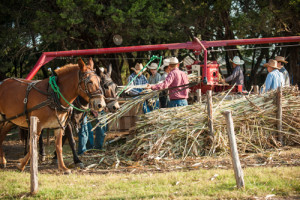 One of the highlights of our year is the late summer harvest of sweet sorghum, an uncommon crop in this day and age. We plant our sorghum fields in an open-pollinated seed variety. This seed, derived from an old heirloom strain, has been improved to give more juice and to grow better and taller than the original variety. After we harvest the cane, we press it at our sorghum mill on the upper land by feeding the ten- to twelve-foot stalks into the horse-powered cane press. The filtered, raw juice slowly cooks as it runs through a series of channels in a twelve-foot stainless steel pan, simmering over a wood fire into sweet, amber-colored sorghum syrup. Hundreds of people come out to watch and learn about the process and enjoy live music, good food and each others’ company at our annual Sorghum Festival.
One of the highlights of our year is the late summer harvest of sweet sorghum, an uncommon crop in this day and age. We plant our sorghum fields in an open-pollinated seed variety. This seed, derived from an old heirloom strain, has been improved to give more juice and to grow better and taller than the original variety. After we harvest the cane, we press it at our sorghum mill on the upper land by feeding the ten- to twelve-foot stalks into the horse-powered cane press. The filtered, raw juice slowly cooks as it runs through a series of channels in a twelve-foot stainless steel pan, simmering over a wood fire into sweet, amber-colored sorghum syrup. Hundreds of people come out to watch and learn about the process and enjoy live music, good food and each others’ company at our annual Sorghum Festival.
As the days begin to shorten and the temperatures dip, showing signs of the approaching fall, we harvest our sweet potato crop. Families gather together for this rewarding harvest, digging and gathering the abundant coppery orange potatoes by hand. Like many Southern farmers of the past, we enjoy sweet potatoes as a staple.
